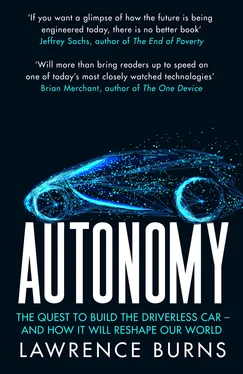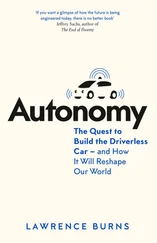
William Collins
An imprint of HarperCollins Publishers
1 London Bridge Street
London SE1 9GF
www.WilliamCollinsBooks.com
This eBook first published in Great Britain by William Collins in 2018
First published in Great Britain by William Collins in 2018
First published in the United States in 2018 by Ecco
Copyright © Lawrence D. Burns, 2018
Lawrence Burns asserts the moral right to be identified as the author of this work
A catalogue record for this book is available from the British Library
All rights reserved under International and Pan-American Copyright Conventions. By payment of the required fees, you have been granted the non-exclusive, non-transferable right to access and read the text of this e-book on-screen. No part of this text may be reproduced, transmitted, down-loaded, decompiled, reverse engineered, or stored in or introduced into any information storage and retrieval system, in any form or by any means, whether electronic or mechanical, now known or hereinafter invented, without the express written permission of HarperCollins
Source ISBN: 9780008302108
Ebook Edition © October 2016 ISBN: 9780008302085
Version: 2019-07-23
‘If you want a glimpse of how the future is being engineered today, there is no better book’
JEFFREY SACHS, author of The End of Poverty
‘An entertaining and accessible account of the biggest disruption in the history of the auto industry, and indeed the entire transportation industry’
RICK WAGONER, former chairman and chief executive officer, General Motors
‘An insider’s view into the thrilling who-will-win-it race to invent and control driverless cars – and the radically altered future that will follow in their wake’
ROBIN CHASE, cofounder, Zipcar, and author of Peers Inc
‘A rich and entertaining insider’s account … required reading for anyone interested in the future of mobility’
ROGER MARTIN, co-author of Playing to Win
‘Tells the remarkable story of innovators who are changing transportation as we know it’
CLAYTON M. CHRISTENSEN, author of The Innovator’s Dilemma
‘Takes us inside the auto industry as it is today – and what may be a very different industry tomorrow’
DANIEL YERGIN, author of The Prize and The Quest
‘Essential reading’
The Times
To engineers, who make what’s possible real
One new idea leads to another, that to a third and so on through a course of time, until someone, with whom no one of these ideas was original, combines all together, and produces what is justly called a new invention.
—Thomas Jefferson
Contents
Cover
Title Page
Copyright
Praise for Autonomy
Dedication
Epigraph
Introduction: The Problem with Cars
PART I: THE TURNING POINT
Chapter One: DARPA’s Grand Challenge
Chapter Two: A Second Chance
Chapter Three: History Happens in Victorville
PART II: THE NEW DNA OF THE AUTOMOBILE
Chapter Four: A Fish Out of Water
Chapter Five: Epiphanies
Chapter Six: Close Only Counts in Horseshoes
PART III: THE AGE OF AUTOMOBILITY
Chapter Seven: The 101,000-Mile Challenge
Chapter Eight: The Seeds of Change
Chapter Nine: The $4 Trillion Disruption
PART IV: THE TIPPING POINT
Chapter Ten: The Stampede
Chapter Eleven: Driving Opportunity
Chapter Twelve: Human Factors
Epilogue: The Quest Goes On
Acknowledgments
A Note on Sources
Index
About the Author
About the Publisher
Introduction
THE PROBLEM WITH CARS
I can’t understand why people are frightened of new ideas. I’m frightened of the old ones.
—JOHN CAGE
The way we get around is changing. For the first time in 130 years, we’re in the midst of a major transformation in automobile transportation. In contrast to the personally owned, gasoline-powered, human-driven vehicles that have dominated the last century, we’re transitioning to mobility services based on electric-powered and driverless vehicles, paid for by trip or through subscriptions.
What does this mean? Soon, many of us will no longer need to own or drive a car. Instead, we will rely on services that safely and conveniently use autonomous vehicles to take us where we want to go. The providers will manage every aspect of our transportation experiences, from vehicle parking to cleaning and maintenance to recharging. The hassles of car ownership will be eliminated. No longer will we need to shop for, finance and insure a car, or spend our time driving, parking or pumping gas. Traffic will be less of a headache. And we will be able to choose between riding in shared vehicles that also serve others or paying more to have an exclusive autonomous “valet” that not only takes us door to door when we want, but also can be dispatched to run errands or transport family and friends.
Summoning a ride will happen with the touch of an app. The vehicle that arrives won’t have a steering wheel or gas and brake pedals. Most trips will happen in electric vehicles tailored to comfortably seat two people, since most trips we make happen solo or with just one other person. All this—and transportation is going to cost us just a fraction of what it ever did before.
This book chronicles the origins of the coming transformation. The changes I describe use current technology to solve the transportation problem in a different way. We don’t often consider transportation a problem, but it is. Without giving it much thought, every day, every one of us considers the dilemma of how to get where we want to go when we want to be there. We come up with various solutions. For more than a century, the predominant solution in North America has been the personally owned, gas-powered, human-operated automobile. But that particular answer has caused numerous issues.
Today in the United States, 212 million licensed drivers own 252 million light-duty vehicles and drive 3.2 trillion miles a year, burning more than 180 billion gallons of fuel as they do. The emissions of cars and trucks amount to a fifth of the greenhouse gases created in the United States. And the distance we travel by automobile is growing, with the number of vehicle miles traveled increasing about 50 percent from 1990 to 2016.
We’ve structured our transportation in such a manner that most working adults believe that owning and maintaining their own vehicles is integral to their full participation in contemporary society. Yet, American automobiles sit unused about 95 percent of the time.
When we do drive those vehicles, they’re terribly inefficient. More than 95 percent of the automobiles sold in the United States today are propelled by internal combustion engines that use gasoline. Less than 30 percent of the energy from the gasoline you put in your car is used to move it down the road. The rest of the energy is wasted as heat and sound, or used to power accessories like headlights, radios and air conditioners. Because typical vehicles weigh around 3,000 pounds and typical people weigh around 150 pounds, only about 5 percent of the gasoline energy translated into motion is used to move the driver, which amounts to just 1.5 percent of the total energy in gasoline.
Читать дальше














